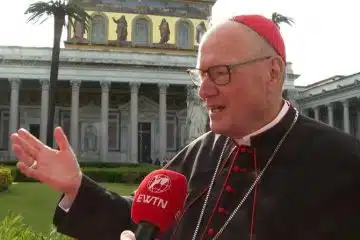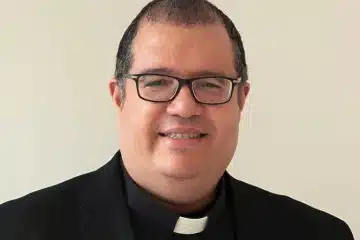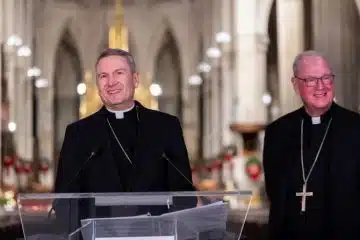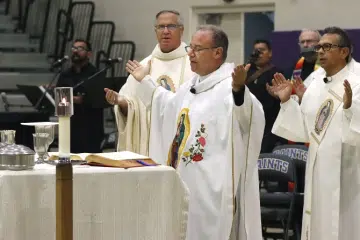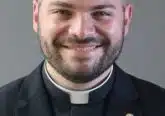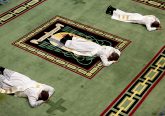Back to Seminary with the New Program for Priestly Formation

Catholic diocesan seminarians head back to campuses and classrooms in August. In some ways, they will have experiences similar to most—days busy with reading texts, attending lectures, writing papers and enjoying extracurricular activities.
Additionally, Catholic seminarians are in the process of formation, as men who will serve God by serving his Church. To highlight and more carefully define the seminary life’s formative aspects, the United States Conference of Catholic Bishops promulgated the sixth edition of the “Program for Priestly Formation” (PPF). The new PPF will be phased in over several years at most diocesan
U.S. seminaries, including Mount St. Mary’s Seminary & School of Theology (MTSM), which begins its second year of implementation in the 2024-25 academic year.
While not neglecting seminary life’s intellectual aspects, the new PPF emphasizes Catholic seminarians’ spiritual and vocational formation to produce pastors who are able to meet priestly life’s ever-changing challenges. Thus, the educational components are more seamlessly integrated into the formative to achieve both purposes in a more hopeful way.
The new PPF implements four tiers of formation: the Propaedeutic, Discipleship, Configuration and Vocational Synthesis stages.
The most significant change is in the propaedeutic stage, similar to the novitiate stage in many religious orders’ formation. From the Latin word for “preparation,” this is a time of concentrated, intentional spiritual discernment, during which the men’s understanding of vocation is challenged and honed. Men in this stage live apart from the other seminarians to the extent possible, in a separate building at MTSM. They pray together in a separate chapel and participate in spiritual, liturgical, manual and recreational activities as a group.
To eliminate distractions, this is also a time of “electronic fasting.” There are no cell phones or other electronic devices during this stage, and, other than for their course work, no internet usage. These first-year seminarians experience a “life of prayer, study, fraternity and appropriate docility to formation” (PPF 120) to test their sense of vocation.
After the propaedeutic phase, seminarians move into the two-year discipleship stage, now fully integrated into seminary life. This includes courses in philosophy, languages and other requirements for the study of theology in later years. Keeping with the new PPF’s theme, this stage is also a time of “systematic and rigorous formation [with] the goal of growing in an intimate relationship with Jesus Christ [and] training in Christian virtue” (PPF 132). This stage builds upon the first one’s spiritual discernment, so that the seminarian “can clearly articulate his call and conviction to be a priest” (PPF 134). These seminarians receive the “Rite of Admission to Candidacy for Holy Orders” at the discipleship stage’s conclusion and move to formation’s third step.
The configuration stage begins the study of theology, and signals movement from discernment to embracing priestly formation and preparation for holy orders. The seminarian is called to “model his life on the self-donation of Jesus Christ” and to cultivate a “properly priestly spirituality” (PPF 135- 36). Seminary education’s spiritual/formative aspects are integrated with the intellectual/academic aspects during this time. The new PPF seeks to train Catholic priests to understand that academic theological knowledge must be carefully combined with spiritual development. The configuration stage emphasizes that purpose, to prepare the seminarian for ordination to the transitional diaconate, this stage’s culmination.
After diaconate ordination, seminarians enter the vocational synthesis stage, where the second-most significant change was made in the PPF’s new edition. As the name implies, this stage’s purpose is to fully synthesize formation’s educational, spiritual and moral aspects into practical, pastoral practice. Transitional deacons spend six months in full-time pastoral practice away from the seminary, living in a rectory and carrying out a pastor’s duties, including administration of sacraments of marriage and baptism.
The new PPF explains that its purpose is to integrate formation’s human, spiritual, intellectual and pastoral dimensions into a well-prepared pastor. These “dimensions are … held in concert with one another,” it explains, so that men who emerge from the seminary are prepared and practiced in the work that lies ahead. I look forward to welcoming them back to Mount St. Mary’s in August to continue their journey.
 Dr. Kenneth Craycraft holds the James J. Gardner Chair of Moral Theology at Mount St. Mary’s Seminary & School of Theology. He is the author of Citizens Yet Strangers: Living Authentically Catholic in a Divided America (OSV 2024).
Dr. Kenneth Craycraft holds the James J. Gardner Chair of Moral Theology at Mount St. Mary’s Seminary & School of Theology. He is the author of Citizens Yet Strangers: Living Authentically Catholic in a Divided America (OSV 2024).
This article appeared in the August 2024 edition of The Catholic Telegraph Magazine. For your complimentary subscription, click here.



